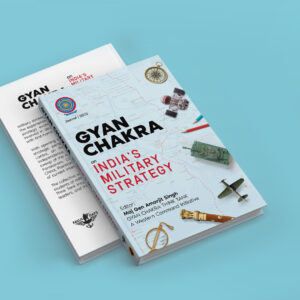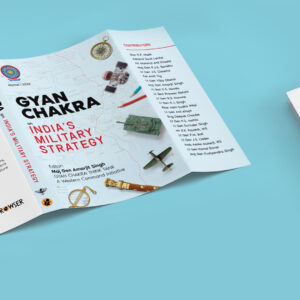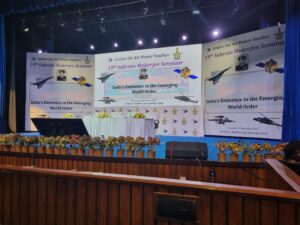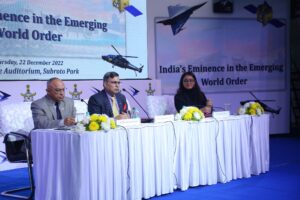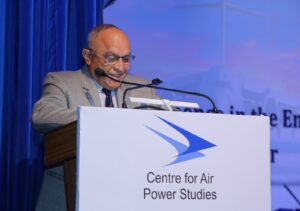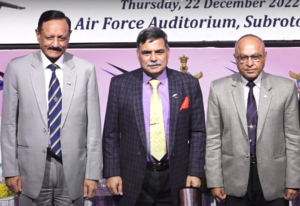? Response to Questionnaire ?
- In your opinion, how do advancements in AI Pilots have the potential to transform future aerial operations and impact Unmanned Aerial Vehicles (UAVs)?
- AI, Quantum Computing, and Miniaturisation are technologies with maximum impact on air warfare. The combination of these increases the computing power of the aerial systems while reducing their weight and size.
- AI-powered UAVs are the future of the air warfare.
- The combination of unmanned aerial platforms and long-range vectors is changing warfare into “No Contact Warfare”.
- Future air warfare will see the next generation of aerial platforms wherein a combination of manned and unmanned platforms will work as a team. The concept is being called the “Loyal Wing Man Concept” (I call it the “Mother Goose Concept”). Work is going on toward it worldwide including India.
- The second future trend is Swarm Technology, wherein, several small (Some as small as insects) drones would work in unison towards a defined task.
- Anti-drone systems will also develop. These systems will contain multi-sensors and an assortment of weapons for hard or soft kill. They will be AI-powered to process the large amounts of information being generated.
- Regarding the critical aspect of securing Air Superiority, particularly in the context of the Sino-Indian Arena and the Indo-Pak scenario, do you believe the Indian Air Force (IAF) is adequately prepared for the challenges of the future? What, in your view, are the essential requirements for the IAF to meet these challenges effectively?
- IAF always works on plans. The first one is to fight with whatever it has and the second is for capability development for future challenges.
- Over the last nine decades (especially in the last four decades) air warfare capabilities (like strategic airlift, precision, Standoff, all-weather round-the-clock operation, high altitude ops, etc.) of the IAF have improved significantly.
- At present IAF still can make the difference and provide the asymmetry while dealing with current challenges. However, its war-fighting endurance (numerical strength of fighter and combat support aircraft) needs to be boosted.
- Capability and capacity development is a continuous process. The future trajectory should cater to future challenges. Some of the essential requirements to deal with future challenges would require:-
-
-
- Enhancement of War Endurance.
-
-
-
- Infusion of Technology (Quantum, AI, Hypersonic, Stealth, etc.)
-
-
-
- Reorientation & reorganisation to deal with Grey Zone operations and warfare in domains of warfare like Cyber, Space, Information, and Electronics.
-
-
-
- Integration with surface forces and government agencies for the whole of government response.
-
-
-
- Self-reliant defence industry.
-
- Recognizing the strategic significance of Space in Future Air Warfare, how imperative do you believe it is for India to make the necessary considerations and investments in this domain?
- Space has permeated into every aspect of life (communications, surveys, education, banking, traffic management, health care disaster management, etc.).
- It has also become an essential domain in warfare (for communications, surveillance, navigation targeting, etc.).
- The long-range vectors Including Hypersonic) and new-generation platforms are using the medium of space.
- In such a scenario of high dependence on space-based systems, space warfare (i.e. denial of space operations to the enemy and freedom of own forces to use the medium of space) both offensive and defensive becomes very important.
- India’s space program is progressing well, however, the space-based technologies and systems are developed first for civilian use and then for the military. This work needs to go on in parallel.
- Private participation besides public R&D and industry is essential.
- An appropriate organisation needs to be set up to harness space and deal with space warfare. Advanced Air Forces like The USAF have a space command. China has gone a step further by making a separate service (Joint Strategic Support Force) to deal with all four domains (Cyber, Space, Information, and Electronic).
Suggestions and value additions are most welcome
For regular updates, please register here
References and credits
To all the online sites and channels.
Disclaimer:
Information and data included in the blog are for educational & non-commercial purposes only and have been carefully adapted, excerpted, or edited from sources deemed reliable and accurate. All copyrighted material belongs to respective owners and is provided only for purposes of wider dissemination.

